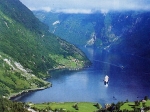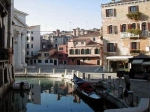Regions in Europe
Map colouring is based on strict geographic definitions. Often the various regions include different countries than those on the map. The inclusion or not of various countries in each region is described below:

Western Europe (red)
Western Europe is always assumed to include: the British Isles ( Great Britain , Ireland ), France and the Benelux (Belgium, the Netherlands, Luxembourg). It usually also includes Germany, though geographically the country may be more central European. In some circumstances, it refers to the entire western half of Europe, including the Iberian Peninsula (Spain, Portugal, Andorra), the Italian peninsula (Italy, San Marino, Vatican City), the Nordic Countries (Norway, Sweden, Finland, Iceland, Denmark) and the Alpine Countries (Germany, Switzerland, Liechtenstein, Austria, Slovenia) and Monaco. Used in a historical or political sense (referring to Cold War divisions), this term may even include Greece and Turkey.
Central Europe (light blue)
Central Europe is not perhaps as common a term as Western or Eastern Europe. Most of the countries included in the definition are often labelled Western or Eastern. A definition of Central Europe usually includes the Visegrad Group (Poland, Czech Republic, Slovakia, Hungary) and often also the Alpine Countries (Switzerland, Liechtenstein, Austria, Slovenia, Germany). According to the most recent usage, Central Europe may even be those countries that joined the European Union on 1 May 2004 . This would mean Poland, Czech Republic, Slovakia, and Hungary (the Visegrad Four); Estonia, Lithuania, and Latvia (the Baltic States ); Slovenia, Cyprus, and Malta.
Eastern Europe (orange)
Similarly to Western Europe, the term Eastern Europe may be used in a strict or broad sense. It includes the European CIS States (Belarus, Kazakhstan, Moldova, Russia, Ukraine), and not seldom the Baltic States (Estonia, Latvia, Lithuania) and Poland. It often includes the Caucasus or Transcaucasian countries (Armenia, Azerbaijan, Georgia), though these are often also regarded as part of Asia . In a broader economic/political context, it may also encompass all of the Visegrad Group (Poland, Czech Republic, Slovakia, Hungary) and the Balkans (Albania, Bosnia and Herzegovina, Bulgaria, Croatia, Greece, Former Yugoslav Republic of Macedonia, Romania, Serbia and Montenegro). During the Cold War , the Eastern bloc Communist states (which belonged to the Warsaw Pact ) were referred to as "Eastern Europe". Often the term included the non Soviet-bloc countries of Albania and the Socialist Republic of Yugoslavia .
Northern Europe (purple/dark blue)
On the map, "Northern Europe" is depicted as only encompassing the Nordic Countries (i.e., " Scandinavia " in the widest sense: Norway, Sweden, Finland, Iceland, Denmark). Some also count Estonia as a Nordic country due to its strong cultural ties with Finland. The term Northern Europe does, however, usually cover a much larger area, in fact an arbitrary part of Europe north of the Alps . Typically, it includes the British Isles (Great Britain and Ireland), the Benelux (Belgium, the Netherlands and Luxembourg), Northern France, Germany, often all the Baltic countries (Estonia, Latvia, Lithuania), sometimes Poland, and on occasion even Russia.
Southern Europe (green)
Southern Europe is a term used in much the same ways as Northern Europe. It includes the Iberian Peninsula (Spain, Portugal, Andorra), the Italian Peninsula (Italy, San Marino, Vatican City), Monaco and the Balkan Peninsula (Albania, Bosnia and Herzegovina, Bulgaria, Croatia, Greece, Former Yugoslav Republic of Macedonia, Romania, Serbia and Montenegro). Usually the remaining Mediterranean States (Cyprus, Malta) and Asia Minor (i.e. Turkey) are also included. In a cultural sense, southern France (including Corsica) may be included.
Asia (light/dark pink)
Some states have territory lying in both Europe and Asia (Russia, Kazakhstan, Turkey, Azerbaijan, Georgia). Their Asian territory is coloured light-pink. Some states that lie entirely on the Asian continent are considered part of Europe because of cultural and historical reasons (Armenia, Cyprus). They are coloured dark-pink. Azerbaijan's exclave of Nakhchivan is also coloured dark-pink because it is not a continuous extension of Azerbaijan's territory.




